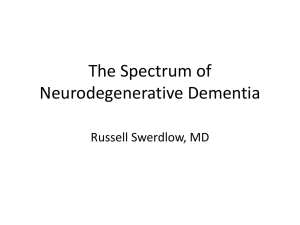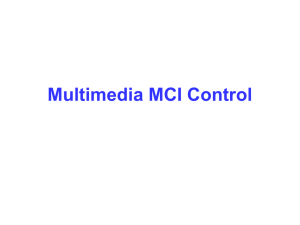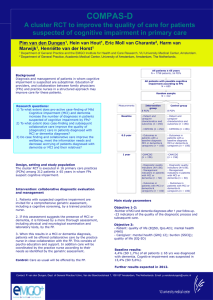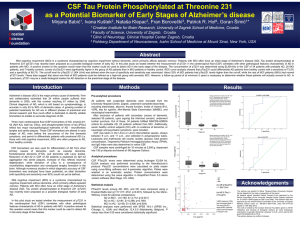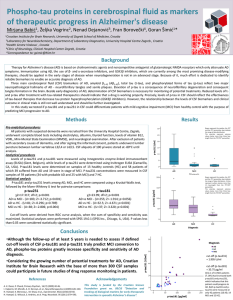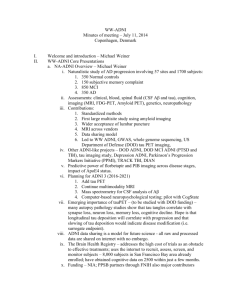AHD 2012 Oct 24 - Gauthier
advertisement
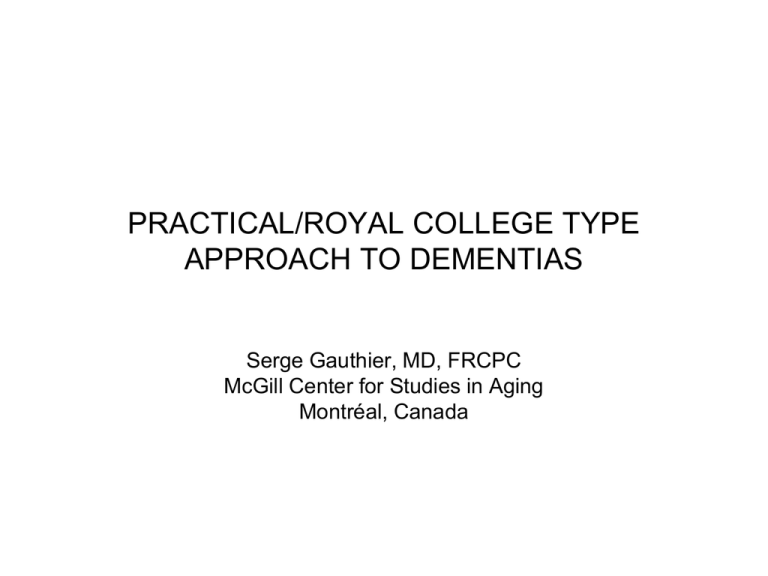
PRACTICAL/ROYAL COLLEGE TYPE APPROACH TO DEMENTIAS Serge Gauthier, MD, FRCPC McGill Center for Studies in Aging Montréal, Canada CONTENT • • • • • Diagnostic issues Current status of pharmacotherapy Studies under way Considerations for use of future drugs CCCDTD4 MoCA ►One-page ► 30-point scale ► 10 minutes to administer www.mocatest.org Alzheimer’s disease exists on a spectrum from minimal symptoms to dementia Increasing Alzheimer’s pathology No symptoms Mild cognitive symptoms Dementia Time • Increasingly severe phenotype • Biomarkers assist in identifying the underlying pathology • Biomarker changes may precede clinically detectable changes © JL Cummings, 2008 Dubois et al., Lancet Neurology 2007 Dubois et al., Lancet Neurology 2007 AD Diagnosis Marching Leftward Presymptomatic AD Onset of AD path No symptoms, biomarker evidence of amyloid dysregulation Modified Dubois criteria: “earlier AD” Very mild symptoms + amyloid biomarker Aisen PS. Alzheimers Res Ther. 2009;1:2. doi:10.1186/alzrt2. Dubois research criteria: “early AD” Episodic memory impairment + any biomarker Standard diagnosis Dementia PIB +ve SPINAL FLUID (CSF) IN AD A42 ↓↓ ↓ or N N AD MCI Cont rol Phosphorylated tau in tangles Tau ↑↑ ↑ or N N Ptau ↑↑ ↑ or N N Total tau in neuronal axons A1-42 in senile plaques AD PROGRESSION USING BIOMARKERS Abnormal CSF Aβ42 Amyloid imaging FDG-PET MRI hippocampal volume CSF Tau Cognitive performance Function (ADL) FDG-PET MRI hippocampal volume Amyloid imaging CSF Aβ42 Cognitive performance Function (ADL) CSF Tau Normal Presymptomatic eMCI LMCI Dementia Aisen PS, Petersen RC, Donohue MC, et al. Alzheimers Dement. 2010;6:239-246. Time Comparison of Clinical, Cognitive, Structural, Metabolic, and Biochemical Changes as a Function of Estimated Years from Expected Symptom Onset. Bateman RJ et al. N Engl J Med 2012;367:795-804 DIAGNOSTIC CRITERIA FOR DEMENTIA PROBABLY DUE TO AD USING BIOMARKERS (Modified from McKhann et al, 2011) Aß • Probable AD with high likelihood • Probable AD with intermediate likelihood • Probable AD dementia • Possible AD dementia + Neuronal injury + + or untested untested or + untested or conflicting results + + (atypical clinical presentation) * Unlikely AD dementia - - DIAGNOSTIC CRITERIA FOR MCI DUE TO AD USING BIOMARKERS (Modified from Albert et al, 2011) Aß + Neuronal injury + • MCI due to AD high likelihood • MCI due to AD + untested intermediate likelihood untested + • MCI possibly due to AD untested or conflicting • MCI unlikely due to AD - DIAGNOSTIC CRITERIA FOR PRECLINICAL AD USING BIOMARKERS (Modified from Sperling et al, 2011) • Asymptomatic cerebral amyloidosis (ACA) • ACA + evidence of neuronal injury (NI) • ACA + NI + subtle cognitive decline Aß Neuronal Symptoms injury + + + - + + + CONTENT • • • • • Diagnostic issues Current status of pharmacotherapy Studies under way Considerations for use of future drugs CCCDTD4 NATURAL HISTORY OF AD AND CURRENT Rx Normal MCI Early L o s s Moderate Severe Terminal 1 2 3 4 5 6 7 8 Temps (ans) ) NATURAL HISTORY OF AD AND CURRENT Rx No standard drug therapy Normal MCI Early L o s s Moderate Severe Terminal 1 2 3 4 5 6 7 8 Temps (ans) ) NATURAL HISTORY OF AD AND CURRENT Rx No standard drug therapy Normal No standard drug therapy MCI Early L o s s Moderate Severe Terminal 1 2 3 4 5 6 7 8 Temps (ans) ) NATURAL HISTORY OF AD AND CURRENT Rx No standard drug therapy Normal No standard drug therapy MCI Antidepressants CIs Early L o s s Moderate Severe Terminal 1 2 3 4 5 6 7 8 Temps (ans) ) NATURAL HISTORY OF AD AND CURRENT Rx No standard drug therapy Normal No standard drug therapy MCI Antidepressants CIs CIs Memantine Early L o s s Moderate Severe Terminal 1 2 3 4 5 6 7 8 Temps (ans) ) NATURAL HISTORY OF AD AND CURRENT Rx No standard drug therapy Normal No standard drug therapy MCI Antidepressants CIs CIs Memantine Early Memantine; CIs Atypical neuroleptics L o s s Moderate Severe Terminal 1 2 3 4 5 6 7 8 Temps (ans) ) NATURAL HISTORY OF AD AND CURRENT Rx No standard drug therapy Normal No standard drug therapy MCI Antidepressants CIs CIs Memantine Early Memantine; CIs Atypical neuroleptics L o s s Memantine; CIs Atypical neuroleptics Moderate Severe Terminal 1 2 3 4 5 6 7 8 Temps (ans) ) EXAMPLE OF MCI STUDY Conversion to AD by Treatment Group 1 yr 1.0 2 yr 3 yr 0.9 0.8 Probability of not 0.7 converting to AD 0.6 Donepezil Vitamin E Placebo 0.5 D–P P=0.416 E–P P=0.912 0.4 0 200 400 600 800 1,000 1,200 Time on MCI study (days) CP1157990-7 EXAMPLE OF MILD TO MODERATE DEMENTIA STUDY DONEPEZIL VS PLACEBO COGNITION (ADAS-cog) Least squares mean change from baseline (±SE) –2.5 ** –2.0 ** –1.5 –1.0 –0.5 ** ** ** ** ** ** ** ** 0.0 ** ** ** Clinical improvement ** 0.5 1.0 Clinical decline 1.5 2.0 US Study† Study‡ 2.5 Placebo 3.0 Aricept: 3.5 5 mg/day Multinational 10 mg/day 4.0 0 6 12 18 Study week Endpoint 30 Placebo washout ITT-LOCF analysis; **p0.001 for Aricept versus placebo †Rogers et al. Neurology 1998;50:136–145; ‡Burns et al. Dement Geriatr Cogn Disord 1999;10:237–244 EXAMPLE OF MODERATE TO SEVERE DEMENTIA STUDY CONCLUSION ABOUT AVAILABLE DRUGS • Current symptomatic drugs are useful in AD, from mild to severe stages of dementia • The advantage of combination of drug classes has not been conclusively demonstrated • The value of CIs in MCI has not been conclusively demonstrated CONTENT • • • • • Diagnostic issues Current status of pharmacotherapy Studies under way Considerations for use of future drugs CCCDTD4 Treating AD: The Amyloid Cascade Hypothesis AGE 30 40 50 60 70 80 90 100 -amyloid deposition Microglial activation Neurofibrillary Neuronal loss/ tangles neurochemical changes DEMENTIA APP gene -Amyloid treatment strategies under study Production APP Antisense Secretase inhibitors & modulators A Monomer Immunotherapy A Oligomer Aggregation A Fibril Deposition Fibrillogenesis modulators Diffuse Plaque Antiinflammatory Senile Plaque Some recent negative trials in AD • Targeting A production – Semagestat (g-secretase inhibitor) – Rosiglitazone (-secretase inhibitor) • Targeting A aggregation - Scyllo-inositol • Targeting A plaques - Bapineuzumab Bengt Winblad Aug, 2012 35 Original Article Clinical and Biomarker Changes in Dominantly Inherited Alzheimer's Disease Randall J. Bateman, M.D., Chengjie Xiong, Ph.D., Tammie L.S. Benzinger, M.D., Ph.D., Anne M. Fagan, Ph.D., Alison Goate, Ph.D., Nick C. Fox, M.D., Daniel S. Marcus, Ph.D., Nigel J. Cairns, Ph.D., Xianyun Xie, M.S., Tyler M. Blazey, B.S., David M. Holtzman, M.D., Anna Santacruz, B.S., Virginia Buckles, Ph.D., Angela Oliver, R.N., Krista Moulder, Ph.D., Paul S. Aisen, M.D., Bernardino Ghetti, M.D., William E. Klunk, M.D., Eric McDade, M.D., Ralph N. Martins, Ph.D., Colin L. Masters, M.D., Richard Mayeux, M.D., John M. Ringman, M.D., Martin N. Rossor, M.D., Peter R. Schofield, Ph.D., D.Sc., Reisa A. Sperling, M.D., Stephen Salloway, M.D., John C. Morris, M.D., for the Dominantly Inherited Alzheimer Network N Engl J Med Volume 367(9):795-804 August 30, 2012 The Dominantly Inherited Alzheimer Network (DIAN) Admin – JC Morris Genetics – AM Goate Clinical – RJ Bateman Imaging – T Benzinger Biomarkers – AM Fagan – D Marcus Therapeutic Trials Informatics Unit Randy Bateman (Director), Virginia Buckles,Neuropathology Matt Carril, Dave Clifford, Biostatistics – C Xiong – NJ CairnsDenise Levitch, Susan Mills, Pam Millsap, John Morris, Krista Moulder, Angela Oliver, Anne Ragland, Anna Santacruz, Natalie Selsor, Wendy Sigurdson, Joy Snider http://www.dian-info.org/ batemanr@neuro.wustl.edu DRUGS SELECTED BY DIAN • Gantenerumab, antibody against aggregated amyloid, from Roche • Solanezumab, monoclonal antibody against soluble amyloid, from Lilly • New beta-secretase inhibitor, from Lilly • • • • • • • proposed preclinical autosomal dominant trial design 300 participants in Colombia – 200 carriers to study efficacy of treatment by comparing change on composite cognitive battery, other clinical measures & biomarkers – cohort study of 100 placebo-treated carrier& non-carriers crenezumab 300 mg SC every 2 weeks up to 18mo for enrollment duration 280 weeks: 6-week screening period, 260-week, double-blind treatment period, and a 14-week f/u (16 weeks after the last dose of study drug) decision-making interim analysis after 104 weeks Smaller US group with variable mutations (n about 30), in collaboration with DIAN Under review by FDA, INVIMA, EC’s/IRB’s CONTENT • • • • • Diagnostic issues Current status of pharmacotherapy Studies under way Considerations for use of future drugs CCCDTD4 USE OF BIOMARKERS MON ITORING FOR NEUROLOGIC COMPLICATIONS New Treatments: SURPRISES WITH ANTI-AMYLOID IMMUNOTHERAPY CD3 T-cell meningeal Vasculitis response to AN-1792 Posterior Reversible Encephalopathy Syndrome (PRES) Accelerated Brain Atrophy Intra-cerebral Microhemorrhage RISKS WITH ANTI-AMYLOID Rx Amyloid Imaging Related Abnormalities (ARIA) • Transient cerebral edema (ARIA-E) • Micro-bleeds (ARIA-H) POSSIBLES RESTRICTIONS IN THE USE OF NEW DRUGS • Stage of disease (MCI vs early dementia) • Diagnosis confirmed by biomarker (MCI) • Responder status confirmed by age, phenotype and genotype (ApoE) • Availability of MRI and neurology resources for short-term complications • Availability of infusion services NEW ETHICAL ISSUES • Early diagnosis in persons with full insight can lead to catastrophic reactions • Access to new treatments will be restricted by the studies inclusion and exclusion criteria • Costs will be high • Stopping rules for treatments are needed CONTENT • • • • • Diagnostic issues Current status of pharmacotherapy Studies under way Considerations for use of future drugs CCCDTD4 CCCDTD4 • Definition (MCI due to AD) • Early onset dementias (need for registry) • Rapidly progressive dementias (need for specialized centers) • Neuroimaging (not ready for prime time) • Liquid biomarkers (CSF more cost-efficient but not popular) • Symptomatic drugs & discontinuation of CIs RECOMMENDATIONS FROM CCCDTD4 ON STOPPING CIs Discontinuing CIs in patients with moderate to severe AD may lead to worsening of cognitive function and greater functional impairment as compared to continued therapy (Grade 2B). This must be balanced with the risk for known side-effects and drug costs if therapy continues. It is suggested that CIs be discontinued when: a) The patient and/or their proxy decision-maker decide to stop after being appraised of the risks and benefits of continuation and discontinuation b) The patient is sufficiently non-adherent with the medication that continued prescription of it would be useless, and it is not possible to establish a system for the administration of the medication to rectify the problem; RECOMMENDATIONS FROM CCCDTD4 ON STOPPING CIs c) The patient’s rate of cognitive, functional, and/or behavioural decline is greater on treatment compared to that prior to being treated; d) The patient experiences intolerable side effects that are definitely or probably related to the CI; e) The comorbidities of the patient make continued use of the agent either unacceptably risky or futile (e.g., terminally ill); f) The patient's dementia progresses to a stage (e.g., Global Deterioration Scale stage 7) where there would be no clinically meaningful benefit from continued therapy. RECOMMENDATIONS FROM CCCDTD4 ON STOPPING CIs When a decision has been made to discontinue therapy because of a perceived lack of effectiveness, it is suggested that the dose be tapered before stopping the agent and that the patient be monitored over the next 1-3 months for evidence of an observable decline. If this occurs, it is suggested that consideration be given to reinstating therapy. (Grade 2C)

